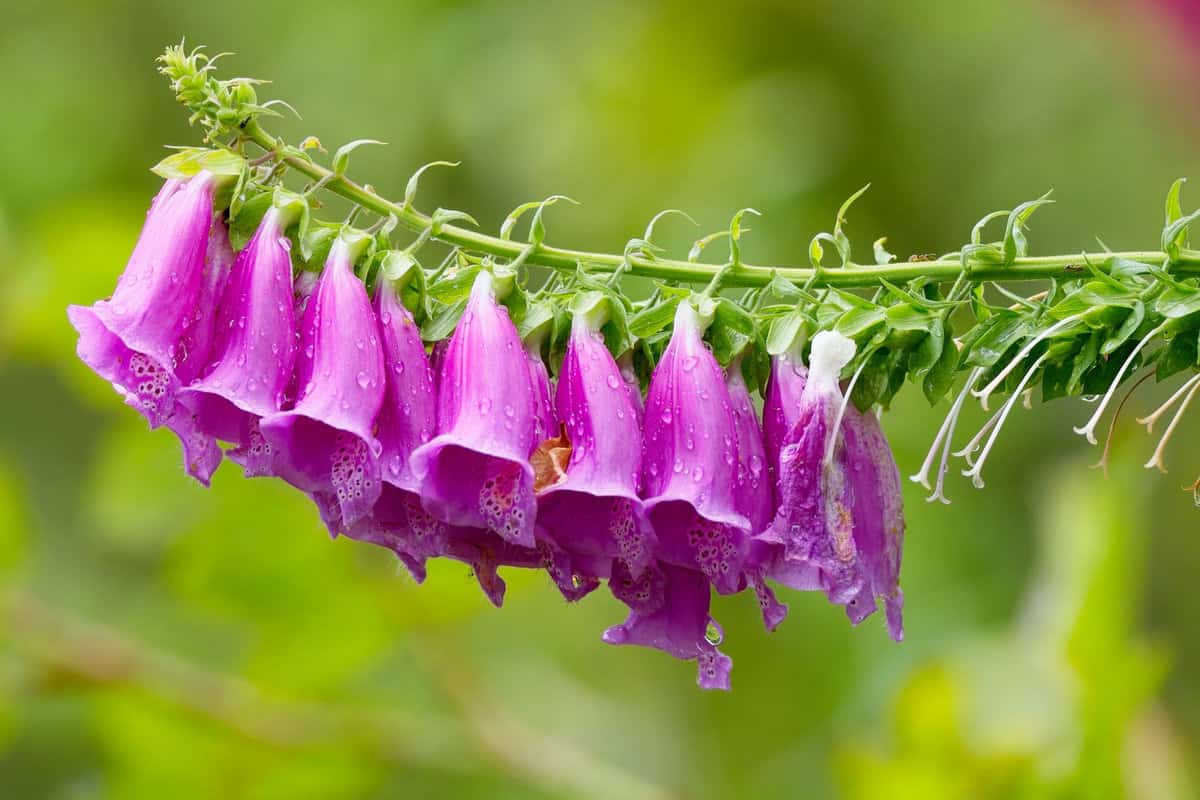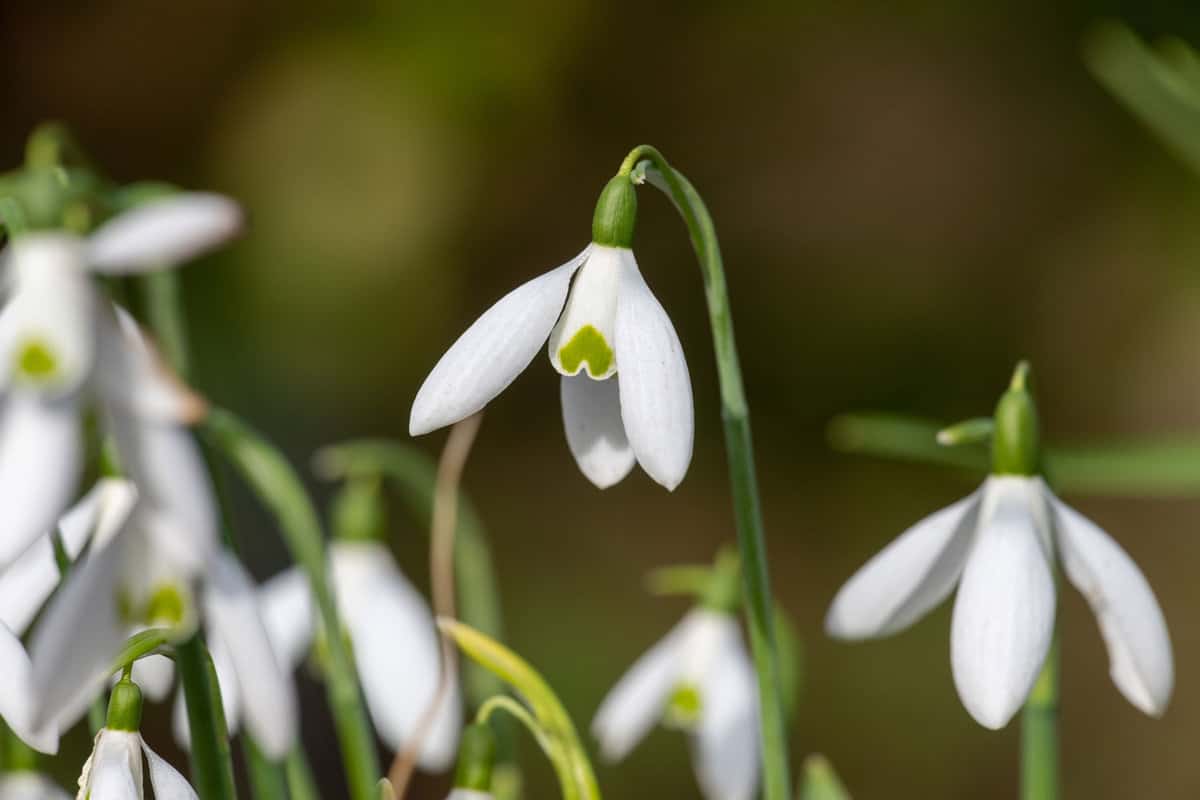Welcome to the vibrant, colorful world of bell-shaped flowers!
With shapes reminiscent of quaint, delicate bells, these flowers are sure to capture the hearts of nature lovers everywhere.

From the elegant Campanula to the enchanting Lily of the Valley, each unique flower brings its own charm and characteristics to your outdoor space.
But it's not just about aesthetics; these resilient perennials are hardy, adaptable, and perfect for adding year-round visual interest to your garden.
So, let's dive in and explore the 11 bell-shaped flowers that will transform your garden into a living masterpiece.
1. Campanula (Bellflower)
Campanula, commonly known as Bellflower, is a charming staple in the garden world.
With its elegant bell-shaped blossoms, it adds an exquisite touch of classic beauty to any outdoor space.

Bellflower's blooms hang like delicate bells, their petals curling out slightly at the edges.
Their shades range from whites to vibrant blues and purples.
But beyond its stunning aesthetics, Bellflower brings more to the garden. It's a resilient perennial, thriving in various conditions and requiring minimal care.
Plus, its long blooming period, from late spring to early fall, provides continuous visual interest.
2. Fuchsia
Fuchsia is known for its vibrant hues. The blooms consist of striking bell-shaped flowers that droop, dangling like exotic lanterns.

Their outer petals curl upwards, revealing a softer, contrasting inner color that adds depth and intrigue.
Additionally, they are a beacon for hummingbirds, inviting these delightful creatures into your garden.
3. Foxglove (Digitalis)
Foxglove, or Digitalis, is a captivating presence in any garden. Renowned for its dramatic height and vibrant colors, it's a flower that commands attention.
Each Foxglove stem bears a collection of bell-shaped blooms. The blooms are arranged in a cascading pattern.

Their speckled throats add an element of intrigue.
Incorporating Foxglove into your garden enriches the landscape in several ways. Their towering presence adds a vertical dimension, bringing depth and layers to your garden design.
Their blooms are also a magnet for bees and other pollinators, supporting local biodiversity.
Foxglove's ability to self-seed and their preference for shady areas make them a practical and versatile choice. With Foxglove, your garden gains height, color, and ecological value.
4. Canterbury Bells (Campanula medium)
Canterbury Bells, a variety of Campanula, are a classic choice. They have an old-world charm and stunning color palette.

The blooms of Canterbury Bells are truly bell-shaped, resembling miniature church bells.
They cluster along tall stems, offering colors that range from delicate pinks and whites to deep purples and blues.
In addition, they are biennials, providing lush foliage in their first year and breathtaking blooms in their second.
Canterbury Bells offer gardeners the ability to plan a spectacle of color and form that unfolds over time, ensuring a garden that captivates across seasons.
5. Bluebells (Hyacinthoides non-scripta)
Bluebells, known scientifically as Hyacinthoides non-scripta, are a beloved sight in springtime.
Their enchanting blue flowers and intoxicating scent make them a popular choice for gardeners everywhere.

The blooms of Bluebells are slender, elegant bells that hang from graceful, arching stems.
Each individual flower is a delicate capsule of rich blue or purple, contributing to a stunning display when planted in swathes.
Planting them in your garden offers multiple benefits. They are excellent for underplanting trees or shrubs, bringing color to otherwise shaded areas.
Their early bloom time fills the gap between spring bulbs and summer perennials, keeping your garden vibrant.
Bluebells are also a favorite of bees and butterflies, promoting pollination and supporting local wildlife.
Read more: Should I Pull Up Dead Bluebells?
6. Harebell (Campanula rotundifolia)
Harebell, or Campanula rotundifolia, is a delightful wildflower.
Known for its delicate beauty and resilience, it's a standout among bell-shaped flowers.

The blooms of Harebell are petite, elegant bells that hang from thin, wiry stems.
Their light blue to violet color adds a subtle touch of coolness to the landscape.
The inclusion of Harebell in a garden yields several benefits. It's a hardy plant that can thrive in a variety of soils, including rocky or sandy environments.
Its long blooming period, from summer to early fall, ensures a continuous display of color. Plus, it's an excellent source of nectar for bees and butterflies.
With Harebell, you're investing in a flower that brings beauty, resilience, and ecological value to your garden.
7. Lily of the Valley (Convallaria majalis)
Lily of the Valley, or Convallaria majalis, is revered for its sweet fragrance and delicate, bell-shaped blooms.

The flowers of Lily of the Valley are tiny, white bells that dangle from slender stems.
Their shape is a perfect bell, and their pure white color shines in the dappled shade where they thrive.
It's an excellent ground cover for shady areas, spreading its glossy leaves and fragrant blooms like a living carpet.
Its bloom time in late spring fills the gap between early spring bulbs and summer perennials.
Beyond its visual and olfactory appeal, Lily of the Valley is also a low maintenance plant, offering beauty without fuss.
8. Enkianthus
Enkianthus offers more than just flowers; it's a plant that provides year-round interest and is a unique choice for any garden.
The blossoms of Enkianthus are small, bell-shaped flowers that dangle from the branches in clusters.

Their colors range from white to pink to red. Its bell-shaped flowers are a visual treat in the spring, while its vibrant fall foliage offers a stunning display of color.
It's also a great option for small gardens due to its compact size. Additionally, Enkianthus is known for its tolerance of various soil conditions, making it a hardy addition to any landscape.
With Enkianthus, your garden gains a versatile, year-round performer.
9. Clematis
Clematis is a versatile flowering vine that brings color, height, and seasonal interest to any garden.
Known for its striking flowers and vigorous growth, it's a garden favorite worldwide.

Clematis boasts a variety of bell-shaped blooms, from small, nodding bells to large, open-face flowers.
Their colors span the spectrum, offering a choice that suits any garden palette.
Adding Clematis to your garden enriches the landscape in many ways. Its climbing habit makes it perfect for vertical gardening, covering walls, trellises, or fences with vibrant color.
Some varieties bloom in spring or summer, while others appear in the fall garden with their flowers, ensuring a seasonal show.
Clematis is also a bee and butterfly magnet, attracting these beneficial insects to your garden.
10. Snowdrop (Galanthus)
Snowdrop, or Galanthus, is a harbinger of spring. Its appearance, often while snow still blankets the ground, signals the end of winter and brings a welcome splash of color.
Snowdrop's blossoms are dainty, bell-shaped flowers that droop from their stems.

They are pure white, giving the appearance of a delicate droplet, a snowy cap against the winter landscape.
Including Snowdrops in your garden extends the blooming season into late winter. Their early emergence brings life to a dormant garden.
Snowdrops are also ideal for naturalizing, spreading gently to form a carpet of white. They're resilient too, thriving in a variety of soils and lighting conditions.
With Snowdrops, your garden gains an early bloomer that combines resilience with beauty.
11. Penstemon (Beardtongue)
Penstemon, commonly known as Beardtongue, is a hardy and versatile perennial.
It's known for its abundance of tubular, bell-shaped flowers.

Penstemon's flowers are elongated bells, bunched in clusters along the stem.
They come in an array of colors, from soft pinks and purples to vibrant reds and blues.
Incorporating Penstemon into your garden provides several benefits. It's drought-tolerant, making it a great choice for xeriscaping or for gardens in drier climates.
Its long blooming period, from late spring to early fall, ensures a steady display of color.
Additionally, Penstemon's flowers are a favorite of hummingbirds and butterflies, inviting these delightful visitors to your garden.
Wrapping Up the Bells of Beauty
Beyond their visual appeal, these flowers also add depth and structure to your garden, invite delightful creatures like hummingbirds and bees, and create a living, breathing canvas that supports local ecosystems.

So why wait? Embrace these bell-shaped treasures and infuse your garden with a blend of timeless elegance, dramatic flair, and ecological value.
You might also want to check this article out:
12 Plants With Red Leaves: Painting Your Garden In Nature’s Fiery Palette
